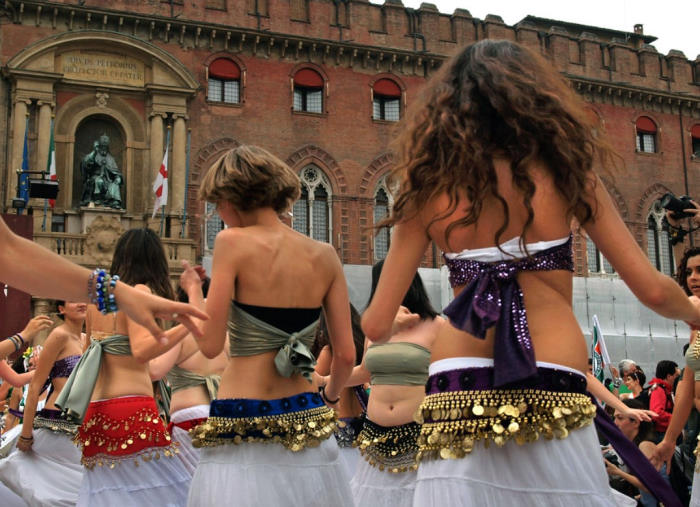If you’re interested in learning about traditional dances, you will probably have read about Belly dancing before. It’s one of the most popular kinds of folk dance that’s still around.
In that case, have you ever wondered “where did Belly dancing come from?”
In this article, we’ll dive deep into the history of Belly dancing. Some of the little-known facts may surprise you!
Table of Contents
Where Did Belly Dancing Come From?
Because it is a folk dance, there are very limited historical documents or sources that pinpoint an exact time, place, or person that made up Belly dancing.
With a brief search online, you’ll find dozens of sources, each with its own interpretations of the history of Belly dancing.
Early belly dancing origins
The precursor to Belly dancing most likely has a European origin. Ancient carvings dated 17,000 years back have been found in caves in Sicily, Italy depicting ancient fertility rituals.
In Ancient Greece, worshippers of Artemis – the Greek Goddess of the Hunt and Moon – also performed a similar rite. They danced while gyrating their hips and belly, which is quite similar to belly dancing as we know it today!
However, as we said, these are simply “precursors” to belly dancing.

Belly dance in the modern world
Today, when we talk of Belly dancing, we’re actually referring to either one of two things. Either an Egyptian dance known as Ghawazi, or an Arabic dance called Raqs Sharqi.
Both of these dances are relatively new developments.
Ghawazi came to being during the 19th century, while Raqs Sharqi became popular in the 20th century.
In both of these dances, the dancers are attired in colorful, rich clothes and perform moves that emphasize their belly and hips.
So, what country started Belly dancing?
It actually has a shared heritage!
Belly dance originated from Africa (Egypt) as well as the Middle East (Arabia) and enjoys influences from the West like Europe and North America!
Why Did Belly Dancing Start?
The original purpose of Belly dancing is as a religious dance. According to Herodotus, a Greek historian, belly dancing was performed at religious festivals in Egypt.
Nowadays, it’s more of a folk and social dance than a religious dance. The Belly dance these days is commonly performed at social gatherings and joyous occasions.
Men and women can dance together in their ordinary clothes, and the objective is to simply have fun!
How Did Belly Dance Come To Western?
The French are to be credited for being the first people to notice and bring belly dance over to the Western world.
During their trip through Egypt in the 18th century, French travelers saw the locals performing the dance and were instantly hooked. They described it as “dance du ventre” (Dance of the Stomach).
From France, news of this exotic dance spread through Europe. In 1893, Belly dance crossed the Atlantic and was brought to the United States by Sol Bloom – a promoter – at the Chicago’s World Fair.
In fact, Sol Bloom may have been the first person to come up with the name “Belly dance”, a term that he used to emphasize the hypnotic hips and belly movement of the dancers.
It’s not surprising that the exotic dance was a huge hit among fair-goers. From Chicago, it spread to Coney Island, then to the rest of the country.
5 Belly Dancing Facts
Egypt is the country that is most well-known for Belly dancing
Of course, when it comes to Belly dancing, the top country people think of is Egypt.
Other than where the dance first came from, it’s also where the top belly dancers in the world have studied and performed. It’s not difficult to find a Belly dance performance or studio in Egypt’s metropolitan centers like Cairo or Luxor.
Plus, if you ever have the opportunity to visit the bustling bazaars in Egypt, there’s a good chance that you’ll be able to see a performance.
You’ll also find shops selling CDs, costumes, accessories, and other knick-knacks related to Belly dancing!
The veil prevails in Belly dance
One of the most distinctive accessories that a belly dancer wears has to be the veil. It’s a gossamer-thin veil hanging across the dancer’s face, usually from the bottom of the nose.
We don’t have a lot of clues as to why veils became a popular accessory for belly dancers to wear. One of the best explanations for this is the character Salome from a play by Oscar Wilde, also called “Salome”.
At one point, Salome dances “The Dance of the Seven Veils” for Herod, who decapitates John the Baptist’s head for her. At the time, the extremely sensual character of Salome was deeply scandalizing, burning into the audience’s minds.
There are other explanations, though, like how the veil was a creation of Loie Fuller, a belly dancer who loved to dance with fluffy skirts and veils.
Or it’s the brainchild of Ivanova, a Russian dance teacher hired by King Farouk of Egypt to teach his daughter how to dance. The veil, worn over each arm, was meant to be a way for the king’s daughter to improve her posture upon her entrance.
What’s the true reason?
Nobody knows!
All of the explanations above sound plausible. We’ll likely never learn about the origin of the veil, but there’s one thing for certain: it’s a permanent fixture of Belly dancing now.
Can males belly dance?
Belly dancing is thought to be a female-only dance. The truth is … not quite!
In many cultures, some male dancers cross-dress as females to dance. For example, in Egypt, this dancer is known as Hawaal.
In highly religious cultures, like in the Arab world, males and females are staunchly segregated. If females were to dance in the presence of males, then that would be considered unbecoming and taboo.
So, what do you do when you want to enjoy female-only dances that are best expressed with feminine grace?
Well, that’s where these dancers come in!
But while a few male dancers perform as “impersonators” in Belly dance, this dance – especially the modern variants – isn’t strictly female-only. Some male belly dancers have become so famous that they developed stage personalities.
While female belly dancers emphasize the grace and fluidity of their belly and hips, male belly dancers entertain the audience by showcasing their abdominal muscles’ strength, agility, and flexibility.
Belly dancing is a tough subject in Islam
Belly dancing is a pretty tough subject in Islam. You will receive a different answer depending on where you go and who you ask.
In mainstream Islam, dancing is considered haram or not allowed. So, by default, Belly dancing is not permitted.
Many countries use this guideline and ban Belly dancing in all forms, even when it’s performed solely among women, and the dancers are fully clothed.
However, many Islamic countries and people out there consider belly dancing an acceptable form of dancing.
As long as it’s “within contexts not forbidden by the Quran or Hadith” and isn’t associated with drugs, alcohol, or extramarital affairs, then it’s fine.
Belly dance can’t flatten your stomach
Belly dancing is extremely healthy and a good to burn off excess fat. When combined with healthy eating, Belly dance can help you lose weight.
However, many people claim that Belly dancing can help flatten your stomach. Sadly, that’s not the case.
Belly dancing does indeed use a lot of the muscle groups in the abdominal region and helps you strengthen them.
However, other than giving you greater strength, the “primary effect” of Belly dancing is to help you burn weight. And as you get slimmer, so do your belly.
If you don’t have a balanced diet or live a sedentary lifestyle, even belly dancing won’t be able to help you achieve a slim, toned belly.
Final Words
Belly dancing more than deserves its spot as one of the top folk-traditional dances in the world. Every performance is an entire experience on its own in beauty and art.
We hope with this short guide to the origin and a few facts about Belly dance, you will have gained a renewed sense of appreciation and wonder for it!
What do you like best about Belly dancing? Do you have any interesting stories or facts that you know about belly dancing origin that you would like to share?
Tell us in the comment section below!

